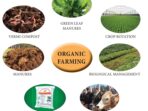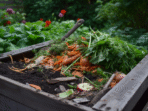Best Crops for Organic Farming Practices is like a treasure map for those who wish to cultivate their green thumbs without resorting to chemical wizardry! Imagine a world where veggies thrive happily in the dirt, free from synthetic shenanigans—sounds like the plot of a feel-good movie, right? Organic farming is not just a trend; it’s a celebration of nature’s bounty, and knowing which crops to plant is the first step to stepping into the role of an eco-friendly farming superhero.
With the right choices, you can grow a colorful variety of produce that not only supports sustainable practices but also tickles your taste buds. From vibrant tomatoes to crunchy greens, the secret to your organic success lies in selecting the best crops that fit your environment and farming style. So grab your gardening gloves, and let’s dig into the world of organic farming!
In a world where cats rule the internet and dogs are the loyal knights of our hearts, it’s time we embark on a grand adventure into the mysterious land of pet ownership. Buckle up your collars and tighten those leashes because we’re about to explore the whimsical, the wacky, and the utterly chaotic life of having a furry friend!Let’s begin with the illustrious canine companion known as the dog.
Now, owning a dog is like having a furry alarm clock that only goes off at the crack of dawn. They don’t come with a snooze button; in fact, they come with a “let’s-go-outside-right-now-or-I-will-pee-on-your-shoes” button. You see, dogs operate on a spectrum of “enthusiastic to over-enthusiastic,” and they are particularly skilled in the art of persuasion, especially when it involves food or a walk.
Chapter One: The Bark-tastic BeginningsPicture this: You walk into a pet store, and your heart is set on a goldfish named Sir Swimsalot, but then you see a puppy with eyes that could melt the hardest of hearts. Before you know it, you’re signing adoption papers for a rambunctious ball of fluff named Sparky. Congratulations! You have just entered the world of dog parenthood—where every day is an adventure and every moment is a potential “oopsie.”But wait! Training begins immediately.
You’ll find yourself channeling your inner dog whisperer, which involves a lot of “No, Sparky! Not the couch!” and “Good boy! Here’s a treat!” You’ll soon realize that treats are not just rewards; they’re the currency of love. You might even consider renaming your dog “Treat Machine” as they become an expert in the art of sitting, staying, and begging for those delectable morsels.
Chapter Two: The Joys (and Noises) of Dog OwnershipNow that you’ve successfully trained your pup to sit (sort of), it’s time to take it out into the world. This is where the real fun begins. You’ll soon discover that dogs have a unique talent for making friends, whether they are other dogs, humans, or inanimate objects like trees and fire hydrants. Expect spontaneous playdates with other four-legged friends and the occasional awkward encounter with a squirrel that seems to be taunting your dog.Walking your dog is like participating in a marathon, only this time the prize is a delicious treat, and the only competition is a squirrel named Nutty McNutface.

You’ve got to keep your eyes peeled because dogs have a knack for finding the most interesting things to roll in—be it mud, grass, or the occasional pile of something that smells suspiciously like yesterday’s lunch.As you navigate this world, don’t be surprised if you find yourself discussing your dog’s bowel movements with fellow dog owners. There’s an unspoken camaraderie that emerges, as you swap tales of “The Great Poop Escape” or “The Mysterious Case of the Missing Chew Toy.” You enter a realm where your social life revolves around puppy playdates and dog-friendly cafes, and your weekends are booked with trips to the dog park.
Chapter Three: The Cat-tastrophe of Cat OwnershipNow, let’s transition to the feline side of life—where cats reign supreme as the aloof rulers of the household. Owning a cat is like living with a furry roommate who has very specific preferences. They may grace you with their presence one moment, only to disappear for hours as they plot world domination from under the couch.You see, cats have mastered the art of “dramatic entrances and exits.” They’ll saunter into the room as if they own the place, and then suddenly decide that the cardboard box in the corner is now their royal throne.
You’ll catch yourself in deep philosophical debates, such as “Why does my cat prefer the box over the extravagant cat bed I bought?” Spoiler alert: It’s because cats are convinced that cardboard is the key to happiness.Feeding a cat is an experience in itself. You might find yourself in a negotiation that would put the United Nations to shame: “Look, Whiskers, I know you love tuna-flavored morsels, but I drew the line at giving you my sandwich!” And let’s not forget the lovely serenade of meows that occur at 3 AM, as your cat demands to be fed, played with, or pampered.
Who needs sleep when you can have a cat walking across your face? Chapter Four: The Joys of Multi-Pet HouseholdsFor the brave souls who decide to embrace the chaos of having both dogs and cats, congratulations! You have unlocked a new level of pet ownership. This is where the real hilarity ensues—picture a dog trying to play fetch while a cat nonchalantly grooms itself atop a shelf, completely indifferent to the shenanigans below.Your home becomes a sitcom set, complete with laugh tracks and unexpected plot twists.
You might witness a dog chasing its tail while a cat judges from a distance, or a cat casually swatting the dog in the face as it tries to explore the mountain of laundry. Every day is a new episode filled with laughter, chaos, and the occasional “Who chewed up the sofa this time?” Chapter Five: The Heartwarming MomentsAmidst the belly laughs and chaos, there are moments that will warm your heart like a cozy blanket on a winter’s day.
There’s nothing quite like the unconditional love of a pet—whether it’s your dog greeting you with a wagging tail and slobbery kisses at the door or your cat curling up on your lap as you binge-watch your favorite show.These moments remind us why we embark on this wild adventure of pet ownership. They teach us about responsibility, companionship, and the joy of living in the present.
You’ll find that your pets have an uncanny ability to sense your moods, offering comfort when you need it the most. They are the ultimate therapists, and their services are always available for free—unless you count the endless supply of treats and toys, of course. Conclusion: The Ultimate Pet Parent ExperienceIn conclusion, owning a pet is an experience like no other—a delightful rollercoaster of laughter, love, and a sprinkle of chaos.
Whether you’re a proud dog parent, a devoted cat owner, or a daring multi-pet household manager, your life will be forever changed by the furry friends that have woofed and meowed their way into your heart.So, dear reader, embrace the messiness, the awkward moments, and the absolute joy that comes with being a pet parent. Fill your days with treats, belly rubs, and the occasional comical mishap.
After all, life is too short not to enjoy the laughter that pets bring into our lives. Grab your leash, find that scratching post, and let the adventures begin!
FAQ Resource: Best Crops For Organic Farming Practices
What are the best crops for beginners in organic farming?
Beginners should consider planting easy-to-grow crops like lettuce, radishes, and beans, as they require less maintenance and grow quickly.
How can I ensure my organic crops are pest-free?
Utilizing natural pest deterrents like neem oil, introducing beneficial insects, and practicing companion planting can help keep pests at bay.
Do organic crops yield less than conventional crops?
While some studies show lower yields for organic crops initially, they often improve over time and provide higher quality produce.
Is it necessary to use organic fertilizers?
While not strictly necessary, using organic fertilizers can enhance soil health and support sustainable farming practices.
How often should I rotate my organic crops?
Crop rotation should ideally occur annually to prevent soil depletion and control pests and diseases.




